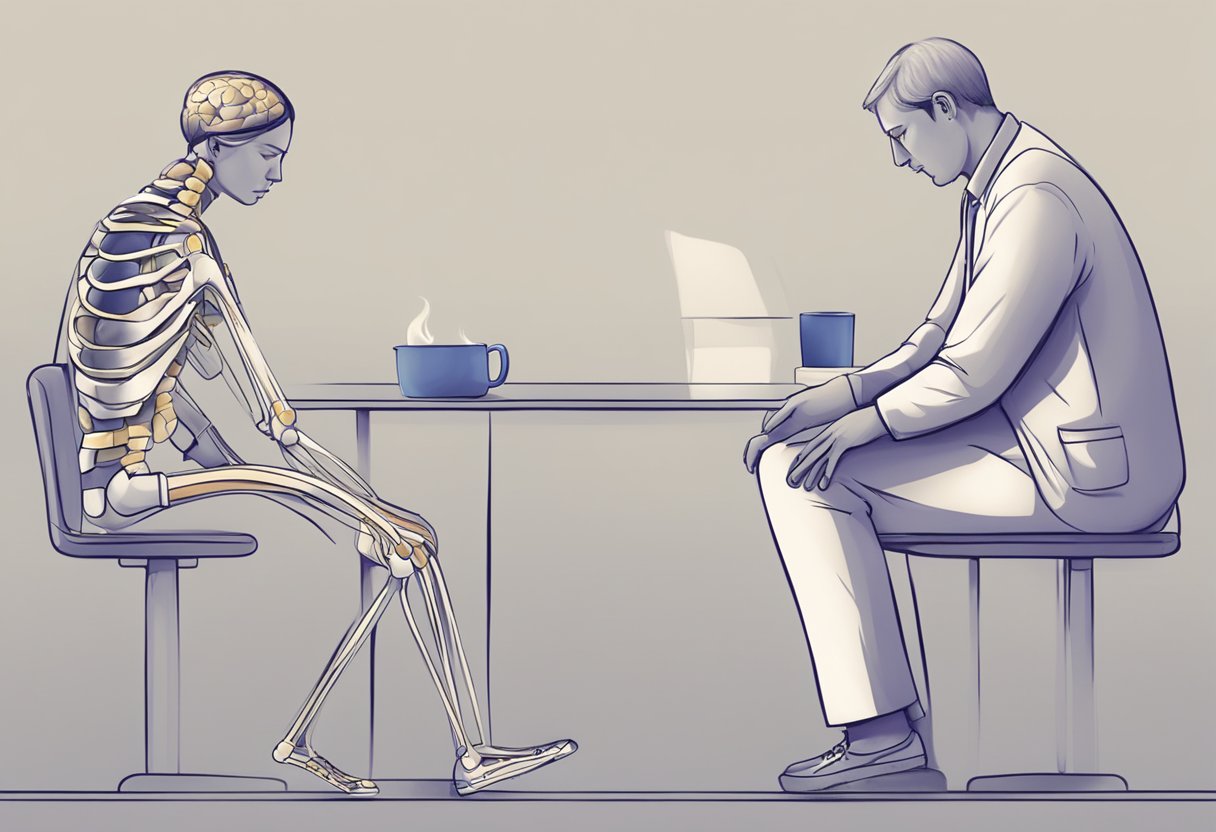Fibromyalgia and polymyalgia rheumatica are two distinct medical conditions that can cause similar symptoms, making it difficult for doctors to diagnose them correctly. Fibromyalgia is a chronic pain disorder characterized by widespread musculoskeletal pain, fatigue, and tenderness in localized areas. Polymyalgia rheumatica, on the other hand, is an inflammatory disorder that causes muscle pain and stiffness in the neck, shoulders, and hips.
While both conditions share some common symptoms, they differ in their underlying causes and treatment options. Fibromyalgia is believed to be caused by an overactive nervous system that amplifies pain signals, while polymyalgia rheumatica is caused by inflammation in the affected muscles. Treatment for fibromyalgia usually involves a combination of medication, physical therapy, and lifestyle changes, while polymyalgia rheumatica is typically treated with corticosteroids to reduce inflammation.
Due to the similarities in symptoms, it is important for patients to receive an accurate diagnosis in order to receive the appropriate treatment. In this article, we will explore the differences between fibromyalgia and polymyalgia rheumatica, their symptoms, causes, and treatment options. By understanding these two conditions, patients and healthcare providers can work together to manage symptoms and improve overall quality of life.
Understanding Fibromyalgia and Polymyalgia Rheumatica
Definition and Overview
Fibromyalgia and Polymyalgia Rheumatica are two different medical conditions that can cause pain and stiffness in the muscles and joints. Fibromyalgia is a chronic condition that affects the muscles and soft tissues of the body. It is characterized by widespread pain, fatigue, and sleep disturbances. Polymyalgia Rheumatica, on the other hand, is an inflammatory disorder that affects the muscles and joints, causing stiffness and pain.
Common Symptoms
The symptoms of fibromyalgia and polymyalgia rheumatica can be similar, but there are some key differences. Common symptoms of fibromyalgia include widespread pain, fatigue, sleep disturbances, and cognitive difficulties. People with fibromyalgia may also experience headaches, irritable bowel syndrome, and depression.
Polymyalgia rheumatica is characterized by stiffness and pain in the muscles, particularly in the shoulders, hips, and neck. People with polymyalgia rheumatica may also experience fatigue, fever, and weight loss. Unlike fibromyalgia, polymyalgia rheumatica is an inflammatory disorder and can cause inflammation in the affected joints.
Key Differences
The key difference between fibromyalgia and polymyalgia rheumatica is the underlying cause of the symptoms. Fibromyalgia is not an inflammatory disorder, and there is no inflammation in the affected muscles and joints. Polymyalgia rheumatica, on the other hand, is an inflammatory disorder and can cause inflammation in the affected joints.
Another difference between the two conditions is the age at which they typically occur. Fibromyalgia can affect people of all ages, but it is more common in women and typically develops between the ages of 30 and 50. Polymyalgia rheumatica, on the other hand, is more common in people over the age of 50.
In conclusion, fibromyalgia and polymyalgia rheumatica are two different medical conditions that can cause pain and stiffness in the muscles and joints. While they share some common symptoms, there are key differences between the two conditions that can help doctors make an accurate diagnosis.
Causes and Risk Factors
Genetic and Environmental Influences
The exact causes of fibromyalgia and polymyalgia rheumatica are not fully understood. However, both conditions are thought to have a combination of genetic and environmental influences. In the case of fibromyalgia, certain genes have been linked to an increased risk of developing the condition. Additionally, environmental factors such as physical or emotional trauma, infections, or stress may trigger the onset of symptoms.
Polymyalgia rheumatica, on the other hand, is believed to be caused by an autoimmune response in the body. This means that the immune system mistakenly attacks healthy tissues, leading to inflammation and pain in the muscles and joints. While the exact triggers of this autoimmune response are not known, genetic factors are thought to play a role.
Age and Gender Specificity
Both fibromyalgia and polymyalgia rheumatica can occur at any age, but they are more commonly diagnosed in older adults. Polymyalgia rheumatica typically affects individuals over the age of 50, while fibromyalgia can affect people of any age, including children.
There is also a gender specificity observed in these conditions. Fibromyalgia is more commonly diagnosed in women than in men, with a ratio of approximately 9:1. In contrast, polymyalgia rheumatica affects both men and women equally.
Risk Factors
There are several risk factors associated with the development of fibromyalgia and polymyalgia rheumatica. For fibromyalgia, these include a family history of the condition, physical or emotional trauma, infections, and stress. In addition, individuals with certain medical conditions such as rheumatoid arthritis, lupus, or osteoarthritis may be more likely to develop fibromyalgia.
For polymyalgia rheumatica, the risk factors include age, gender, and genetics. Individuals with a family history of the condition or other autoimmune disorders may also be at an increased risk. In addition, certain viruses such as parvovirus B19 have been linked to the development of polymyalgia rheumatica.
Overall, while the exact causes of fibromyalgia and polymyalgia rheumatica are not fully understood, research suggests that a combination of genetic and environmental factors play a role in their development. Understanding these risk factors can help individuals take steps to reduce their risk and manage their symptoms.
Diagnosis and Tests
Clinical Assessment
Diagnosing fibromyalgia and polymyalgia rheumatica can be challenging, as both conditions share similar symptoms such as muscle pain and stiffness. A thorough clinical assessment is necessary to differentiate between the two conditions. The doctor will ask about the patient’s medical history and perform a physical exam to check for tender points, joint swelling, and other symptoms.
Laboratory Tests
Laboratory tests can be helpful in confirming the diagnosis of polymyalgia rheumatica. Blood tests such as c-reactive protein (CRP) and erythrocyte sedimentation rate (ESR) are usually elevated in patients with polymyalgia rheumatica. However, these tests are not specific to the condition and can also be elevated in other inflammatory conditions.
Differential Diagnosis
Differential diagnosis is important in distinguishing fibromyalgia from polymyalgia rheumatica. Fibromyalgia is a diagnosis of exclusion, meaning that other conditions with similar symptoms must be ruled out before a diagnosis can be made. Other conditions that can mimic fibromyalgia include chronic fatigue syndrome, hypothyroidism, and depression.
A rheumatologist is a specialist who can help diagnose and manage both fibromyalgia and polymyalgia rheumatica. They are trained to recognize the subtle differences between the two conditions and can perform additional tests if necessary.
Treatment Strategies
When it comes to treating fibromyalgia and polymyalgia rheumatica, there are a variety of strategies that may be employed. Treatment plans will vary from patient to patient, depending on the severity of their condition and their individual needs.
Medication Options
Medication is often a key component of treatment for both fibromyalgia and polymyalgia rheumatica. For fibromyalgia, medications such as pain relievers, antidepressants, and anti-seizure drugs may be prescribed to help manage symptoms. For polymyalgia rheumatica, corticosteroids are typically the first line of treatment, as they can help reduce inflammation and ease pain.
Physical and Complementary Therapies
In addition to medication, physical and complementary therapies may also be helpful in managing symptoms. For fibromyalgia patients, regular exercise and physical therapy can help improve flexibility, reduce pain, and increase overall well-being. Complementary therapies such as acupuncture, massage, and meditation may also be beneficial.
For polymyalgia rheumatica patients, physical therapy can help improve mobility and reduce pain. Additionally, complementary therapies such as massage and acupuncture may also be helpful in managing symptoms.
Lifestyle and Support
Lifestyle changes and support can also play a key role in managing symptoms of both fibromyalgia and polymyalgia rheumatica. For fibromyalgia patients, stress reduction techniques and healthy sleep habits can be helpful in managing symptoms. Support groups can also provide valuable emotional support and coping strategies.
For polymyalgia rheumatica patients, it is important to maintain a healthy diet and engage in regular exercise to help manage symptoms. Support from family and friends can also be beneficial in managing the emotional toll of the condition.
Overall, a comprehensive treatment plan that includes medication, physical and complementary therapies, and lifestyle changes can help improve symptoms and quality of life for patients with fibromyalgia and polymyalgia rheumatica.
Living with Chronic Conditions
Living with chronic conditions such as fibromyalgia or polymyalgia rheumatica can be challenging. However, with appropriate management techniques, individuals can lead a fulfilling life.
Managing Pain and Discomfort
Chronic pain is a common symptom of both fibromyalgia and polymyalgia rheumatica. Pain management techniques such as taking prescribed medications, physical therapy, and regular exercise can help alleviate discomfort. Additionally, individuals can try alternative therapies such as acupuncture, massage, and meditation to help manage pain.
Psychological and Emotional Support
Living with chronic conditions can also take a toll on an individual’s mental and emotional well-being. It is important to seek psychological and emotional support from a therapist or counselor to help cope with stress, depression, and anxiety. Joining support groups can also provide a sense of community and understanding among individuals who are going through similar experiences.
Long-Term Outlook
Both fibromyalgia and polymyalgia rheumatica are chronic conditions that require long-term management. It is important to work closely with a healthcare provider to develop an appropriate treatment plan that includes regular check-ups, monitoring of symptoms, and medication management. Additionally, individuals should prioritize self-care techniques such as getting enough rest, eating a healthy diet, and engaging in regular physical activity to help improve overall quality of life.
Living with chronic conditions can be challenging, but with appropriate management techniques and support, individuals can lead fulfilling lives.


